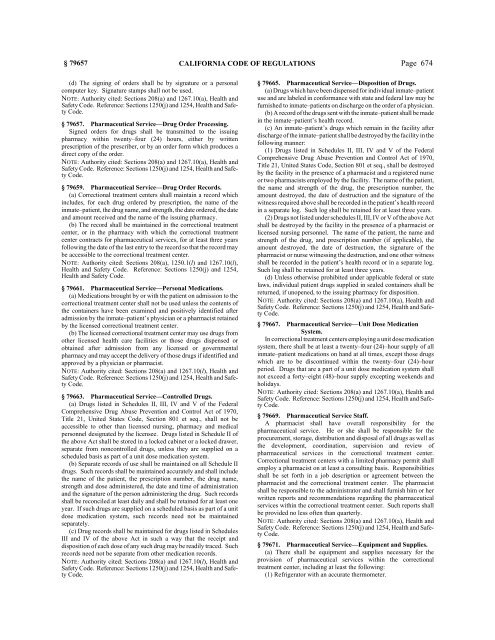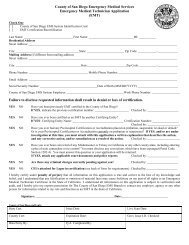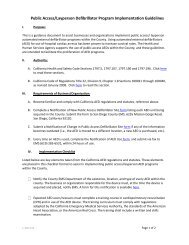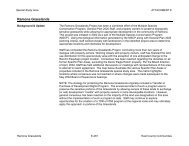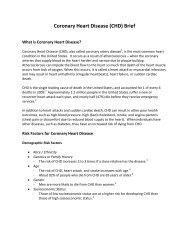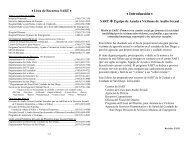CALIFORNIA CODE OF REGULATIONS - State of California
CALIFORNIA CODE OF REGULATIONS - State of California
CALIFORNIA CODE OF REGULATIONS - State of California
You also want an ePaper? Increase the reach of your titles
YUMPU automatically turns print PDFs into web optimized ePapers that Google loves.
§ 79657 <strong>CALIFORNIA</strong> <strong>CODE</strong> <strong>OF</strong> <strong>REGULATIONS</strong><br />
Page 674<br />
(d) The signing <strong>of</strong> orders shall be by signature or a personal<br />
computer key. Signature stamps shall not be used.<br />
NOTE: Authority cited: Sections 208(a) and 1267.10(a), Health and<br />
Safety Code. Reference: Sections 1250(j) and 1254, Health and Safety<br />
Code.<br />
§ 79657. Pharmaceutical Service—Drug Order Processing.<br />
Signed orders for drugs shall be transmitted to the issuing<br />
pharmacy within twenty–four (24) hours, either by written<br />
prescription <strong>of</strong> the prescriber, or by an order form which produces a<br />
direct copy <strong>of</strong> the order.<br />
NOTE: Authority cited: Sections 208(a) and 1267.10(a), Health and<br />
Safety Code. Reference: Sections 1250(j) and 1254, Health and Safety<br />
Code.<br />
§ 79659. Pharmaceutical Service—Drug Order Records.<br />
(a) Correctional treatment centers shall maintain a record which<br />
includes, for each drug ordered by prescription, the name <strong>of</strong> the<br />
inmate–patient, the drug name, and strength, the date ordered, the date<br />
and amount received and the name <strong>of</strong> the issuing pharmacy.<br />
(b) The record shall be maintained in the correctional treatment<br />
center, or in the pharmacy with which the correctional treatment<br />
center contracts for pharmaceutical services, for at least three years<br />
following the date <strong>of</strong> the last entry to the record so that the record may<br />
be accessible to the correctional treatment center.<br />
NOTE: Authority cited: Sections 208(a), 1250.1(l) and 1267.10(l),<br />
Health and Safety Code. Reference: Sections 1250(j) and 1254,<br />
Health and Safety Code.<br />
§ 79661. Pharmaceutical Service—Personal Medications.<br />
(a) Medications brought by or with the patient on admission to the<br />
correctional treatment center shall not be used unless the contents <strong>of</strong><br />
the containers have been examined and positively identified after<br />
admission by the inmate–patient’s physician or a pharmacist retained<br />
by the licensed correctional treatment center.<br />
(b) The licensed correctional treatment center may use drugs from<br />
other licensed health care facilities or those drugs dispensed or<br />
obtained after admission from any licensed or governmental<br />
pharmacy and may accept the delivery <strong>of</strong> those drugs if identified and<br />
approved by a physician or pharmacist.<br />
NOTE: Authority cited: Sections 208(a) and 1267.10(l), Health and<br />
Safety Code. Reference: Sections 1250(j) and 1254, Health and Safety<br />
Code.<br />
§ 79663. Pharmaceutical Service—Controlled Drugs.<br />
(a) Drugs listed in Schedules II, III, IV and V <strong>of</strong> the Federal<br />
Comprehensive Drug Abuse Prevention and Control Act <strong>of</strong> 1970,<br />
Title 21, United <strong>State</strong>s Code, Section 801 et seq., shall not be<br />
accessible to other than licensed nursing, pharmacy and medical<br />
personnel designated by the licensee. Drugs listed in Schedule II <strong>of</strong><br />
the above Act shall be stored in a locked cabinet or a locked drawer,<br />
separate from noncontrolled drugs, unless they are supplied on a<br />
scheduled basis as part <strong>of</strong> a unit dose medication system.<br />
(b) Separate records <strong>of</strong> use shall be maintained on all Schedule II<br />
drugs. Such records shall be maintained accurately and shall include<br />
the name <strong>of</strong> the patient, the prescription number, the drug name,<br />
strength and dose administered, the date and time <strong>of</strong> administration<br />
and the signature <strong>of</strong> the person administering the drug. Such records<br />
shall be reconciled at least daily and shall be retained for at least one<br />
year. If such drugs are supplied on a scheduled basis as part <strong>of</strong> a unit<br />
dose medication system, such records need not be maintained<br />
separately.<br />
(c) Drug records shall be maintained for drugs listed in Schedules<br />
III and IV <strong>of</strong> the above Act in such a way that the receipt and<br />
disposition <strong>of</strong> each dose <strong>of</strong> any such drug may be readily traced. Such<br />
records need not be separate from other medication records.<br />
NOTE: Authority cited: Sections 208(a) and 1267.10(l), Health and<br />
Safety Code. Reference: Sections 1250(j) and 1254, Health and Safety<br />
Code.<br />
§ 79665. Pharmaceutical Service—Disposition <strong>of</strong> Drugs.<br />
(a) Drugs which have been dispensed for individual inmate–patient<br />
use and are labeled in conformance with state and federal law may be<br />
furnished to inmate–patients on discharge on the order <strong>of</strong> a physician.<br />
(b) A record <strong>of</strong> the drugs sent with the inmate–patient shall be made<br />
in the inmate–patient’s health record.<br />
(c) An inmate–patient’s drugs which remain in the facility after<br />
discharge <strong>of</strong> the inmate–patient shall be destroyed by the facility in the<br />
following manner:<br />
(1) Drugs listed in Schedules II, III, IV and V <strong>of</strong> the Federal<br />
Comprehensive Drug Abuse Prevention and Control Act <strong>of</strong> 1970,<br />
Title 21, United <strong>State</strong>s Code, Section 801 et seq., shall be destroyed<br />
by the facility in the presence <strong>of</strong> a pharmacist and a registered nurse<br />
or two pharmacists employed by the facility. The name <strong>of</strong> the patient,<br />
the name and strength <strong>of</strong> the drug, the prescription number, the<br />
amount destroyed, the date <strong>of</strong> destruction and the signature <strong>of</strong> the<br />
witness required above shall be recorded in the patient’s health record<br />
in a separate log. Such log shall be retained for at least three years.<br />
(2) Drugs not listed under schedules II, III, IV or V <strong>of</strong> the above Act<br />
shall be destroyed by the facility in the presence <strong>of</strong> a pharmacist or<br />
licensed nursing personnel. The name <strong>of</strong> the patient, the name and<br />
strength <strong>of</strong> the drug, and prescription number (if applicable), the<br />
amount destroyed, the date <strong>of</strong> destruction, the signature <strong>of</strong> the<br />
pharmacist or nurse witnessing the destruction, and one other witness<br />
shall be recorded in the patient’s health record or in a separate log.<br />
Such log shall be retained for at least three years.<br />
(d) Unless otherwise prohibited under applicable federal or state<br />
laws, individual patient drugs supplied in sealed containers shall be<br />
returned, if unopened, to the issuing pharmacy for disposition.<br />
NOTE: Authority cited: Sections 208(a) and 1267.10(a), Health and<br />
Safety Code. Reference: Sections 1250(j) and 1254, Health and Safety<br />
Code.<br />
§ 79667. Pharmaceutical Service—Unit Dose Medication<br />
System.<br />
In correctional treatment centers employing a unit dose medication<br />
system, there shall be at least a twenty–four (24)–hour supply <strong>of</strong> all<br />
inmate–patient medications on hand at all times, except those drugs<br />
which are to be discontinued within the twenty–four (24)–hour<br />
period. Drugs that are a part <strong>of</strong> a unit dose medication system shall<br />
not exceed a forty–eight (48)–hour supply excepting weekends and<br />
holidays.<br />
NOTE: Authority cited: Sections 208(a) and 1267.10(a), Health and<br />
Safety Code. Reference: Sections 1250(j) and 1254, Health and Safety<br />
Code.<br />
§ 79669. Pharmaceutical Service Staff.<br />
A pharmacist shall have overall responsibility for the<br />
pharmaceutical service. He or she shall be responsible for the<br />
procurement, storage, distribution and disposal <strong>of</strong> all drugs as well as<br />
the development, coordination, supervision and review <strong>of</strong><br />
pharmaceutical services in the correctional treatment center.<br />
Correctional treatment centers with a limited pharmacy permit shall<br />
employ a pharmacist on at least a consulting basis. Responsibilities<br />
shall be set forth in a job description or agreement between the<br />
pharmacist and the correctional treatment center. The pharmacist<br />
shall be responsible to the administrator and shall furnish him or her<br />
written reports and recommendations regarding the pharmaceutical<br />
services within the correctional treatment center. Such reports shall<br />
be provided no less <strong>of</strong>ten than quarterly.<br />
NOTE: Authority cited: Sections 208(a) and 1267.10(a), Health and<br />
Safety Code. Reference: Sections 1250(j) and 1254, Health and Safety<br />
Code.<br />
§ 79671. Pharmaceutical Service—Equipment and Supplies.<br />
(a) There shall be equipment and supplies necessary for the<br />
provision <strong>of</strong> pharmaceutical services within the correctional<br />
treatment center, including at least the following:<br />
(1) Refrigerator with an accurate thermometer.


